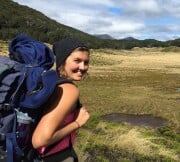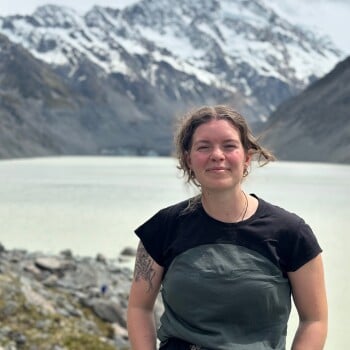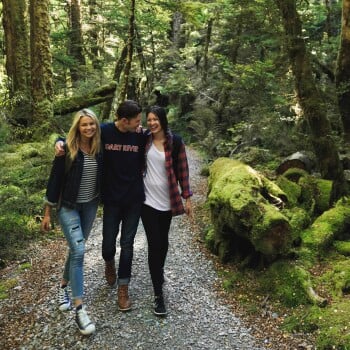- About Us
-
Trips
-
 Kiwi-Style Hiking
Kiwi-Style Hiking
-
 Great Walks
Great Walks
-
 Hiking Tours
Hiking Tours
-
Alpine Hikes
-
Custom Groups
- Huayhuash Trek
- Family Northern Explorer
- Family Southern Explorer
- Lake Waikaremoana Hike
- Women's Custom Tours
- Women's Southern Wilderness
- Coast, Canyons and Mountains
- Coastal Wanderer Custom Tour
- Don't Cross the Ladies
- Secret South Custom Tour
- Tekapo Hike
- West Coast Custom Tour
- World Heritage Custom Tour
-
- Blog
- Shortlist
- About Us
- Trips
- Blog
- Shortlist

May 29, 2018
Five amazing facts about the New Zealand landscape you probably never thought to ask
Where can I see a lateral moraine sitting on top of volcanic debris? (Wait, what even is a lateral moraine?)
A lateral moraine is a ridge of debris formed on the sides of a glacier from material (glacial till) carried on the glacier. When the glacier melts or ablates it piles up. They are common features of landscape with has been formed by glaciers. It is rather unusual, however, to see a lateral moraine sitting on top of the debris left from volcanic eruptions. One place you can witness this is in the Mangatepopo Valley on the western side of Tongariro National Park in the central North Island. Take a walk in this awesome alpine environment, and impress your friends by saying, “Look, a lateral moraine sitting on volcanic debris!”

What is a parasite cone and where can I see one in New Zealand/Aotearoa?
Mt Taranaki, on the west coast of the North Island, looming over the city of New Plymouth, is, from certain vantage points, almost Fuji-esque in its conical perfection. From its south side, though, there is another peak which appears to be growing out of it. This secondary peak is Mt Fantham/Panitahi and is a good example of a parasitic volcanic cone which forms from vent eruptions on the slopes of a larger cone. You can walk up Mt Fantham for a closer look at the peak, and even stay the night in the hut near the summit if you wish. Much more interesting than a perfect cone!
What is a ria river valley? And… isn’t that the same as a fjord?
Fiordland, in the southwest corner of the South Island is a must-see part of New Zealand for many tourists--cruising its flooded glacial valleys is an unforgettable experience. More accessible, though--via, most conveniently, the Cook Strait Ferry which links the North and South Islands -are the Marlborough Sounds which are also stunning and geologically fascinating in their own right. Unlike the sounds of Fiordland, the Marlborough Sounds are river valleys, formed by the flooding of river/water created valleys (fluvial) rather than glacial activity. Caused by a combination of land subsidence and sea level rise, these sounds are not quite as mountainous, but still feature a similarly spectacular effect of land plunging directly into the sea.
Where in NZ does the land descend from a 3000 metre mountain peak to the coast completely uninterrupted by human development?
If you were to climb New Zealand’s highest peak outside the Aorangi/Mt Cook region, Mt Aspiring, which is 3033 metres high, and then head west, you would eventually reach the coast, south of the tiny West Coast settlement of Haast without encountering even a meandering coastal road. Okay, in reality, this adventure in the rugged wilderness of Mt Aspiring National Park and the wilderness of Southwestland would be very difficult. Even with the requisite mountaineering skills, there is not a direct route that will take you from Aspiring to the coast, though there are many other single and multi-day walks in this beautiful area. All of these will give you a sense of the majestic wilderness that is one of the rare places in the world where the land descends between mountain peaks and wild coast untouched by civilization.
Why are some South Island rivers full of green boulders?
If you are travelling in the north or west of the South Island, you may notice that some of the rivers are full of distinctive green boulders. This is not just a visual trick caused by the water rushing over them - what you are seeing may be pounamu, the precious greenstone known elsewhere as jade (watch out for serpentine, pounamu’s equivalent to fools’ gold - similar in look but not strength). It has been collected and carved into weapons and jewellery by Maori for centuries. In recognition of its cultural value to Maori, in 1997 ownership of all the pounamu resource in the South Island was given back to the Ngai Tahu people of the South Island. A simple greenstone pendant is a popular souvenir for tourists to NZ, and there is practically no limit to the intricacy and beauty of the jewellery and carvings available to view and purchase at many places around the country. If you are really lucky, you might find a small piece of pounamu on one of the West Coast beaches, sanded smooth by eons of water and glacial activity.








